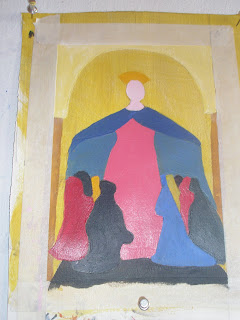 Seeing Michelangelo's David and his unfinished Captive Slaves at the Accademia on Saturday made me think of this little scene in my (alas) unpublished novel, Italian Lessons:
Seeing Michelangelo's David and his unfinished Captive Slaves at the Accademia on Saturday made me think of this little scene in my (alas) unpublished novel, Italian Lessons:They made their way through the crowded streets to the Accademia, where the line stretched the length of the building and around the corner. It moved steadily, though—and there was good people-watching to pass the time. Young lovers, rambunctious clusters of college students; families with bored, impatient children; married couples leafing through their guidebooks; middle-aged women, like themselves. Near the entrance to the museum, there was a mime draped in white muslin, with a white muslin headdress and white makeup on her face and hands. She stood perfectly still on a low white base, infinitesimally moving her head or a hand each time someone threw a coin into the hat offered by her assistant.
Once inside the museum, they had to thread their way through a crowd of people to see the David, which stood, gleaming, at the end of a long gallery. He had been placed high on his marble pedestal, surrounded by a wrought iron barrier that made him safe from the touch of careless tourists who would have worn him away, given the chance. Five American girls, blond, giggling, leaned against the barrier, and a man they had pressed into service stepped back to snap photographs with each of the five cameras that his wife handed him, smiling. When he’d finished and handed the cameras back to them, the girls moved on, never turning to look at the sculpture. Instantly, a group of Japanese tourists took their place. The repeated clicking of shutters was audible; people walked slowly around the sculpture, their video cameras capturing it
from each angle.
Lucy and Isabel stood and looked at him a long time, circled round to see him from every angle. Light fell from the domed ceiling, casting parts of him into shadow, making other parts of him gleam. The marble was so white, whiter than any marble Lucy had ever seen.
“He’s such a boy,” Isabel said finally. “His hand, it’s like my boys’ hands. God, and did he get it: the way boys stand, the way they are their bodies at that age. I don’t care what the copy looks like in the Piazza Whatever. I wouldn’t have missed this for anything.”
 Lucy agreed. But what she loved best were the Captives, four figures for the Julius tomb that Michelangelo had begun and abandoned. They were nothing like the David. The most nearly finished of them was bearded, his eyes closed, his head bent with the weight of the stone still upon it; his raised arm strained to lift it away, but it was only half made. There was no hand at all, just rough, pitted marble.
Lucy agreed. But what she loved best were the Captives, four figures for the Julius tomb that Michelangelo had begun and abandoned. They were nothing like the David. The most nearly finished of them was bearded, his eyes closed, his head bent with the weight of the stone still upon it; his raised arm strained to lift it away, but it was only half made. There was no hand at all, just rough, pitted marble. This was a middle-aged body, fit, but thickening in the torso and waist. Not glorious, like David’s. Hard work, the kind of brute force this man exerted now against the stone had made it strong, and, looking at him, Lucy couldn’t help thinking that, even if he were real and free, the world would not make an easy place for him.
The David seemed to have appeared in the universe by some miracle of birth, she thought, bearing no visible evidence of his creator’s hand upon him. But in these unfinished figures, you saw the stuff of the earth from which they were made, the mark of the chisel, the way the artist worked his way through parallel planes of marble in search of the figure deep what each of us might be, strains and goes weary captured, bound by the limits of what real life brings.
The cares of the morning fell away, and it seemed to Lucy that even if she saw nothingelse the whole time she was in Italy, even if life with Delia, Sydney, and Eileen in the next days continued to bring forth every doubt she’d ever had about herself, the trip would have been worth taking because it had brought her to this place.















